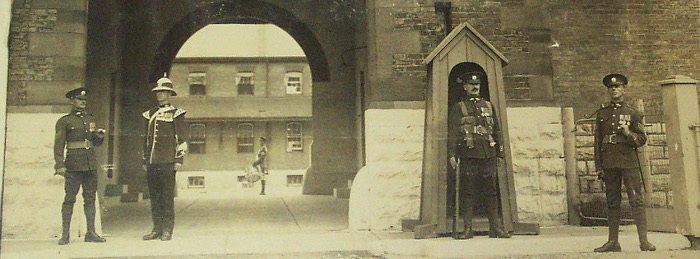Topic: Drill and Training

Organization of Infantry
So long as one member of a section remains effective, it will retain its identity. Only if less than three other ranks are available for duty may it be attached temporarily to another section of its platoon. It will resume its independent existence as soon as its regains a strength of three other ranks,…
Infantry Training, Vol. 1, 1922, Provisional
[1.] The detailed organization of an infantry battalion is as follows [Footnoted: This organization of a battalion is a war organization. The peace organization is that laid down in peace establishments which will be published later.]:
i. A battalion consists of:…
- Headquarters,
- Headquarters wing,
- Four companies.
It is commanded by a lieutenant-colonel, with a major as second in command.
ii. The headquarters wing of a battalion consists of four groups:…
No. 1 Group.…Composed of the personnel of the light mortar section with two light mortars; signallers, scouts, and stretcher bearers, batmen to battalion headquarters, anti-aircraft (Lewis) gunners and orderlies.
No. 2 Group.…The personnel of the machine gun platoon with eight machine guns.
No. 3 Group.…The personnel employed primarily for administrative duties, but available for fighting in an emergency.
No. 4 Group.…Regimental transport and necessary personnel.
The headquarters wing is commanded by the senior group commander.
iii. A company consists of:…
- Headquarters,
- Four platoons.
It is commanded by a major or captain, with a captain as second in command.
The four companies of a battalion are designated by serial letters or numbers.
iv. A platoon consists of:…
- Headquarters,
- Two rifle sections,
- Two Lewis gun sections.
It is commanded by a subaltern, with a serjeant as second in command (platoon serjeant).
The platoon is the largest infantry unit composed of men whose only duty is fighting. It is thus the tactical unit of infantry.
Platoons are numbered serially from 1 to 16 in the battalion.
v. The section is the infantry fire unit. Its members must regard themselves as a team and stick to one another and to their leader in peace as in war.
Sections are numbered serially from 1 to 16 in a company. The odd numbers are rifle sections, the even numbers, Lewis gun sections.
[2.] The above organization is fixed and definite, and, except as paid down in para. [3.] below, must never be varied. Only when a force is uniformly organized can every part of it be relied on by its commander to carry out the same orders in the same way. Organization quickly degenerates into disorganization when its uniformity is sacrificed.
[3.] By means of its organization a battalion is best able to stand the shock of battle, to surmount confusion, and to suffer casualties with the least injury to its efficiency. To maintain the organization, in or out of battle, no matter what the difficulty, is one of the first duties of every commander. To abandon it is to destroy fighting power and capacity for training. The following rules will, therefore, be strictly enforced:—
i. So long as one member of a section remains effective, it will retain its identity. Only if less than three other ranks are available for duty may it be attached temporarily to another section of its platoon. It will resume its independent existence as soon as its regains a strength of three other ranks, i.e., the strength necessary to enable it to act independently as a rifle or Lewis gun "fire unit."
ii. The transfer of N.C.Os. And men from one section to another, except for purposes of promotion, will be avoided.
iii. Endeavours must be made to retain the full number of sections in being during training periods, in order that 16 section commanders may be trained in each company. The training of the section commander is more important than the training of the private soldier.
iv. Sections will normally be maintained as strong as the strength of the battalion will permit; their numbers will consequently vary. Section commanders must learn to work with varying numbers of men in their sections.
v. If a platoon falls below an effective strength of two sections (each of three other ranks) it may be attached temporarily to another platoon in the same company, but its identity will be retained and it will resume its separate existence as soon as it regains the necessary strength.
vi. Platoon commanders should not be moved from one platoon to another unless the transfer is intended to be permanent, nor should an officer be brought in temporarily from another platoon to fill the place of an absent platoon commander. Thus a serjeant or corporal will often act as platoon commander.
vii. An understudy will be nominated and trained for every platoon and section commander.
viii. Working parties, guards, and other duties will be formed by complete units (companies, platoons, or sections) under their own commanders. Duty rosters will be kept by complete units, not on alphabetical company rolls.
ix. During active operations, to assist in reforming a battalion after a battle, a nucleus…minimum 50 other ranks…will, when circumstances permit, be left out of the fight. These men must be selected with great care according to their qualifications as instructors, &c., for the work of reconstruction. They will not be available as reinforcements during the battle.

